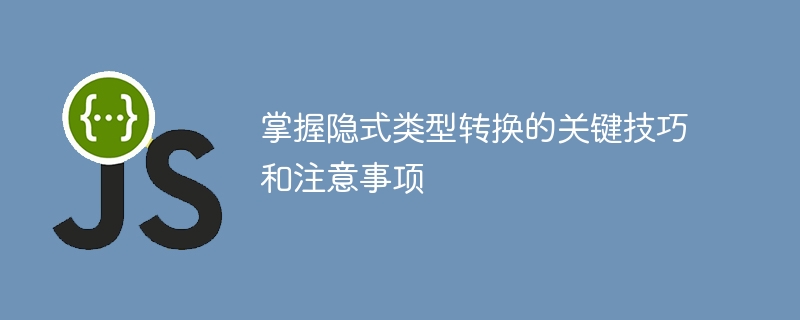

Key skills and precautions for mastering implicit type conversion
Implicit type conversion is an important concept often encountered in programming. It refers to the fact that in some cases, a programming language automatically converts one data type to another without the programmer having to perform an explicit type conversion operation. Understanding the key techniques and precautions of implicit type conversion can help us write more concise and efficient code.
1. Basic Concepts
Before discussing implicit type conversion, let’s first understand the classification of data types. Data types can be divided into basic data types and reference data types. Basic data types include integers, floating point numbers, characters, Boolean, etc.; while reference data types include arrays, objects, functions, etc. Implicit type conversion mainly occurs between basic data types.
2. Principles of implicit type conversion
For example:
var num1 = 10; // 整数类型 var num2 = 3.14; // 浮点数类型 var result = num1 + num2; // 隐式将整数转换为浮点数 console.log(result); // 输出 13.14
For example:
var str1 = "Hello"; var num1 = 10; var result = str1 + num1; console.log(result); // 输出 "Hello10"
For example:
var bool1 = true; var bool2 = false; var result1 = bool1 + 10; // 隐式将 true 转换为 1 var result2 = bool2 - 5; // 隐式将 false 转换为 0 console.log(result1); // 输出 11 console.log(result2); // 输出 -5
3. Notes
For example:
var num1 = 3.14; var result = num1 | 0; // 隐式将浮点数转换为整数 console.log(result); // 输出 3
var result1 = undefined + 3; // undefined 转换为 NaN console.log(result1); // 输出 NaN var result2 = null + 3; // null 转换为 0 console.log(result2); // 输出 3
4. Summary
Mastering the key skills and precautions of implicit type conversion will help us write more concise and efficient code. During the programming process, implicit type conversion should be used reasonably according to actual needs to avoid unnecessary problems. However, over-reliance on implicit type conversion may make the code difficult to understand and maintain. Therefore, in some complex cases, it is recommended to perform type conversion explicitly to increase the readability and reliability of the code.
The above is the detailed content of Master the key points of implicit type conversion techniques and precautions. For more information, please follow other related articles on the PHP Chinese website!
 Introduction to java core technology content
Introduction to java core technology content
 What is the difference between 4g and 5g mobile phones?
What is the difference between 4g and 5g mobile phones?
 Problems with your wireless adapter or access point
Problems with your wireless adapter or access point
 What are the commonly used functions of informix?
What are the commonly used functions of informix?
 How to generate random numbers in js
How to generate random numbers in js
 navigator.appname
navigator.appname
 The running environment of java program
The running environment of java program
 ^quxjg$c
^quxjg$c
 Computer application areas
Computer application areas




